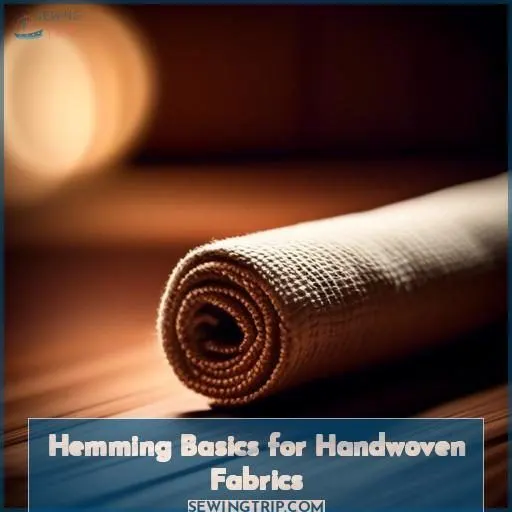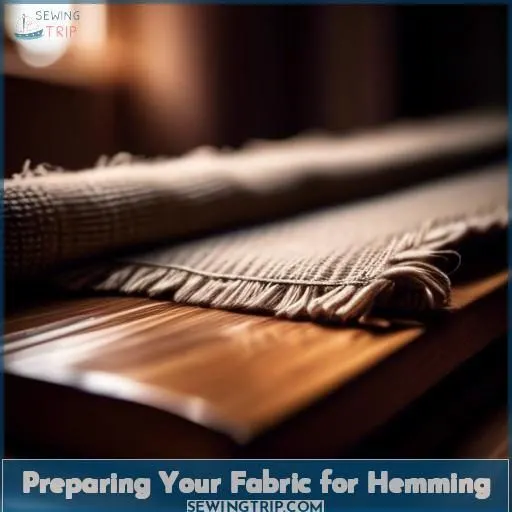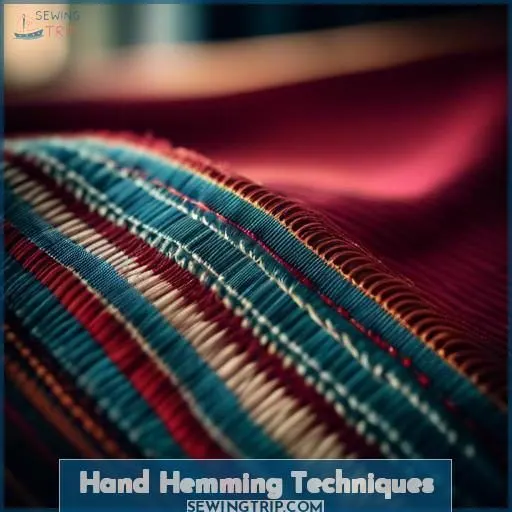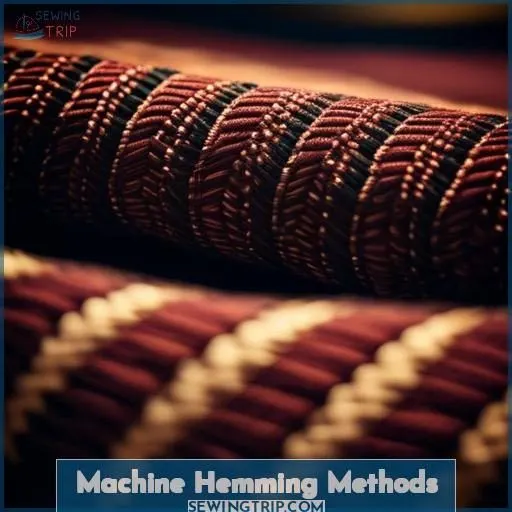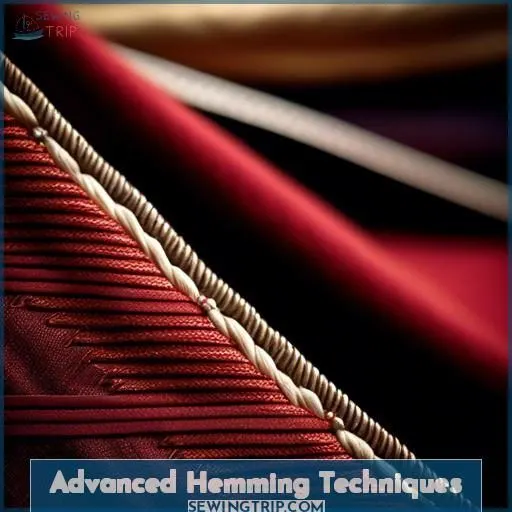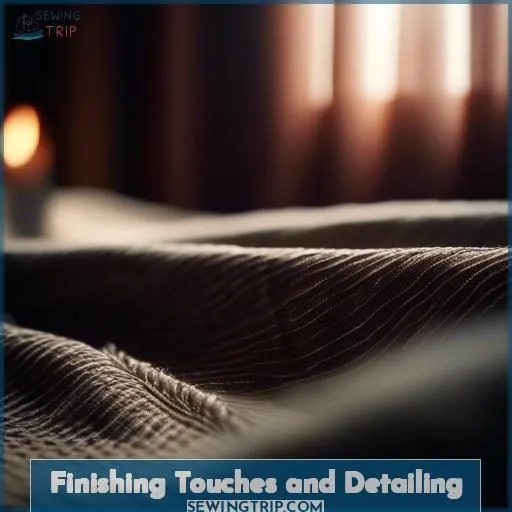This site is supported by our readers. We may earn a commission, at no cost to you, if you purchase through links.
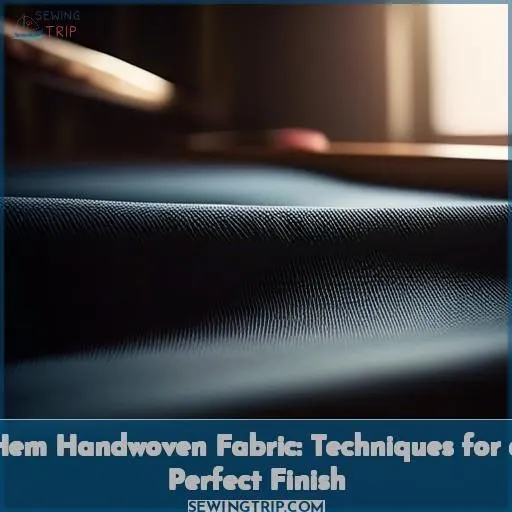
To hem a handwoven fabric, you’ll first want to protect the raw edges with a zigzag stitch or serging.
Press the fabric thoroughly to reduce bulk and flaring before hemming.
Use finer weft thread and a medium zigzag stitch when machine hemming for a nice finish.
For hand hemming, choose a complementary needle, tuck away frays with folding techniques, and dance consistent stitches along the hem’s edge for an invisible finish.
Wet finishing the fabric beforehand helps achieve the desired drape and texture.
Proper techniques guarantee your handwoven treasure’s unique qualities shine through the expertly finished hems.
There’s more to explore.
Table Of Contents
- Key Takeaways
- How Do You Hem a Hand Woven Fabric?
- Hemming Basics for Handwoven Fabrics
- Preparing Your Fabric for Hemming
- Hand Hemming Techniques
- Machine Hemming Methods
- Special Considerations for Towel Projects
- Advanced Hemming Techniques
- Finishing Touches and Detailing
- Frequently Asked Questions (FAQs)
- Conclusion
Key Takeaways
- Protect raw edges with a zigzag stitch or serging before hemming.
- Use finer weft thread and a medium zigzag stitch for machine hemming.
- Tuck away frays with folding techniques for hand hemming.
- Wet finishing the fabric beforehand helps achieve the desired drape and texture.
How Do You Hem a Hand Woven Fabric?
To hem a hand-woven fabric, you can use a hand-sewing technique such as a Hong Kong seam finish or a welt seam finish.
For a Hong Kong seam finish, you’d first stay stitch the hem and then sew a flat fell seam. This involves folding the raw edges of the fabric toward each other and sewing them together.
For a welt seam finish, you’d fold the hem over twice and sew it down.
You can also use a hand-sewing needle and thread to stitch the hem, making sure to knot the end of the thread and bury it into the cloth.
If you prefer to use a sewing machine, you can follow the same steps as for a hand-sewn hem but use the machine to sew the stitches.
Hemming Basics for Handwoven Fabrics
Hemming handwoven fabrics requires careful preparation to guarantee a clean and tidy finish. Serging the raw edges and pressing the fabric before hemming will make the process much easier and help reduce bulk and flaring.
Importance of Serging and Pressing
Securing raw edges before hemming is imperative to avert unraveling during wet finishing, a prevalent procedure for handwoven fabric. This technique entails employing a zig zag stitch to safeguard the raw edge and bar it from fraying.
Should you favor a manually stitched hem, you can resort to a needle and thread to stitch adjacent to the folded edge.
For hems sewn by machine, employ a straight stitch close to the folded edge, reinforcing the start and finish with backstitching for enhanced durability.
Techniques for Reducing Bulk and Flaring
When working with handwoven fabric, it’s important to pay close attention to the hemming process to guarantee a clean and professional finish. One technique that can help minimize bulk and flaring in the hem is the dog ear technique. This method involves folding in a corner on each side of the hem and pressing it down with an iron. This not only conceals corners and reduces flared ends but also helps to prevent the fabric from fraying or unraveling during wet finishing.
Another way to reduce bulk and flaring is by using a finer weft thread in the hem section compared to the body of the fabric. This can help lessen the flaring effect, especially when the hem is woven in plain weave but the body of the piece is woven in a structure with fewer interlacements per inch.
When sewing by machine, it’s essential to use a medium zig zag stitch to provide a nice finish. Sew close to the folded edge but not over it, and remember to reverse stitch at the start and finish of the hem.
For hand hemmed projects, consider using needle and thread to sew the hem close to the folded edge. This will provide an almost unnoticeable finish.
Lastly, when working with towels, it’s important to plan for extra hem in the project design. This will help ensure that the long side hem tucks into the double folded hem at the ends, creating a less bulky hem.
Preparing Your Fabric for Hemming
Before you start hemming your handwoven fabric, it’s essential to protect the raw edges. You can do this by running a zig-zag stitch along the edges or leaving them raw, but be sure to wash the fabric first to settle the threads.
Securing Raw Edges
Before you begin hemming your handwoven fabric, it’s imperative to secure the raw edges to prevent unraveling during wet finishing. You can use a zig zag stitch to attach the woven panels or serge the raw edge.
If you’re sewing handwoven fabric with a sewing machine, consider weaving thinner yarn picks at the start for a less bulky hem. Alternatively, you can use a contrasting thread to mark fold lines.
Don’t forget to wash your project before hemming to settle the threads.
Wet Finishing Techniques
Wet finishing is an essential step in preparing your handwoven fabric for hemming. This process involves washing your fabric after it has been cut off the loom to clean the yarn and help the threads settle into their final positions within the cloth structure. Here are some key points to keep in mind when wet finishing your handwoven fabric:
- Cleaning the yarn: Mild detergent can be used to remove any spinning oil or sizing in the yarns, ensuring that your fabric is clean and ready for hemming.
- Gentle agitation: Wet finishing allows the threads to relax, bend, bloom, and settle into their final resting locations within the cloth structure. This process helps the fabric achieve its desired appearance and texture.
- Pressing: After washing and rinsing your fabric, press it with a hard iron to lock in the integrity of the cloth. Press one side at a time, and even if the item will never again see an iron, this step is indispensable in creating good cloth.
- Drying: Depending on the fabric’s composition and intended use, you may need to lay the fabric flat to dry or use other methods, such as a dryer or pressing with a steam iron.
Hand Hemming Techniques
Hand hemming a handwoven fabric can create an almost invisible finish. To get this look, you’ll need the right needle, thread, and some careful stitching techniques.
Steps for Invisible Hand Hemming
After securing your fabric’s raw edges, it’s time to finesse your hand stitching. Choose a needle that complements your textile focus, and employ folding techniques to tuck away the fray. With needle in hand, dance a straight stitch along the hem’s edge, keeping stitch length consistent. This invisible seam is your secret handshake into the guild of handwoven fabric artisans.
Tools and Thread Selection
Hemming handwoven fabric is a vital step in ensuring the longevity and professional appearance of your project. In terms of tools and thread selection, there are several key considerations to bear in mind. Here are some tips:
- Thread Quality and Durability: Choose a premium thread, such as Gutermann Sew-All Polyester Thread, renowned for its strength and versatility. This thread is suitable for both hand and machine sewing and is resistant to fraying and color running.
- Machine Needle Size: For machine hemmed projects, use a needle size appropriate for the fabric and thread. A larger needle can help prevent breakage and ensure a smooth stitch.
- Hand Needle Size: For hand hemmed projects, choose a hand needle size that’s comfortable for you to use. A smaller needle can make the process easier and more precise.
- Stitch Tension: Ensure proper stitch tension to prevent puckering or uneven stitches. This can be adjusted on your sewing machine or by hand-sewing techniques.
Machine Hemming Methods
When hemming handwoven fabric, take the time to set up your sewing machine properly. Choose a sturdy sewing thread and the right stitch to guarantee your hem lies flat and looks professional.
Setting Up Your Sewing Machine
Before you start hemming your handwoven fabric, you need to prepare your sewing machine.
Start by adjusting the tension to guarantee a neat stitch. Select the appropriate needle for your fabric and thread type. Set the presser foot pressure in accordance with your fabric’s thickness.
Wind the bobbin with the corresponding thread and launder your project before hemming.
If you’re working with multiple layers, consider using a walking foot for consistent feeding.
Choosing the Right Stitch and Thread
Regarding machine hemming, selecting the appropriate stitch and thread is vital for a long-lasting and aesthetically pleasing result.
For towels, Gutermann sewing thread is widely used due to its resilience.
As you consider stitch options, a medium zig zag can produce a desirable finish.
Or a straight stitch positioned near the folded edge is also suitable.
Make certain that the thread tension is properly adjusted and the stitch length is compatible with the fabric’s characteristics.
The objective is to create a hem that seamlessly integrates with the fabric, as exemplified by meticulously researched projects at Ontario College of Art and Design University.
Special Considerations for Towel Projects
When hemming towel projects, you’ll want to examine the different techniques for long edges versus end hems.
For the long edges, a single fold hem can provide an attractive, straight edge.
While the end hems often require a double-folded hem to neatly enclose the bulkier corners.
Additionally, you can introduce design elements like contrasting woven borders or folding guides into the hemming process to enhance the final look and aid in obtaining precise folds.
Hemming Long Edges Vs. End Hems
Hemming long edges and end hems in towel projects requires careful planning. Here’s how to approach it:
- Hem placement: Determine hem placement based on project design and desired finish.
- Hemming allowances: Factor in extra fabric for hemming in your project design.
- Planned hems: Complete side hems before end hems for a more accurate finish.
- Folded edges: Encase raw edges and corners with second folds to prevent flaring.
Incorporating Design Elements in Hems
After mastering the long edge hem, let’s jazz it up! Design incorporation isn’t just fluff; it’s the secret sauce to towel envy. Think color contrast for a pop, woven borders that scream chic, and decorative stitching that dances along the edge. And don’t forget pattern matching – it’s like the hem’s secret handshake with the rest of the towel.
Advanced Hemming Techniques
You’ll want to master the dog ear technique to achieve crisp, professional-looking corners on your handwoven pieces. This involves folding in the corners before pressing and encasing them within the hem, resulting in a neat finish without unsightly flaring.
Additionally, using a walking foot on your sewing machine guarantees even feeding of the multiple fabric layers, preventing bunching or puckering for a flawless appearance.
Dog Ear Technique for Corners
To create a dog ear tuck, start by folding the corner inward on both sides of the hem.
Press the folded corners down with an iron to hide them and reduce a flared hem.
Then, fold the raw edge over and press again.
Place pins to hold the folds in place.
This technique guarantees a pressed finish while hiding unsightly corners.
Using a Walking Foot for Even Feeding
When hemming handwoven fabric, particularly with multiple layers, it’s crucial to guarantee uniform feeding for a flawless finish. This is where a walking foot proves invaluable. A walking foot is a sewing machine foot that uniformly feeds layers of fabric and batting through the machine, preventing movement and wrinkling that might occur with a regular presser foot.
A walking foot has an additional set of teeth that assist it in navigating bulky seams, making it perfect for traversing multiple layers of fabric. It operates by moving the top layer at the same rate as the bottom layer, eliminating misalignment and ensuring a smooth finish.
To utilize a walking foot for hemming, follow these steps:
- Connect the walking foot to your sewing machine, positioning the movable bar so it rests atop your machine’s needle bar.
- As you sew, the walking foot’s teeth will move in harmony with your machine’s feed dogs beneath the fabric, guaranteeing uniform feeding.
- This uniform feeding is particularly advantageous when sewing knit fabrics, which have a tendency to stretch under the presser foot, causing wrinkling or movement.
Finishing Touches and Detailing
After securing your hem, invest time to carefully press and trim the finished edge to achieve a crisp, professional appearance. Enhance the aesthetic by thoughtfully incorporating decorative elements such as contrasting topstitching, bias binding, or a delicate lace edging that harmonizes with the handwoven nature of your fabric.
Pressing and Trimming the Finished Hem
Ironing and Snipping the completed hem is an essential step in achieving a professional appearance for your handwoven fabric. Here are three key steps to guarantee a flawless finish:
- Folding Methods: Select the appropriate folding method based on the fabric and desired effect. For instance, a single fold hem provides a clean, straight edge, while a double fold hem adds volume but conceals raw edges.
- Needle Types and Thread Tension: Choose the appropriate needle type and thread tension for your sewing machine to ensure smooth stitching and avoid missed stitches.
- Stitch Length and Seam Allowance: Adjust your stitch length and seam allowance to suit the fabric and desired effect. A shorter stitch length and smaller seam allowance create a more invisible hem, while longer stitches and larger seam allowances provide more durability.
Adding Decorative Elements to Enhance Aesthetics
To add decorative elements to your handwoven fabric hem, consider the following techniques:
- Contrasting Thread: Use a contrasting thread color for the hem stitching to create a visually appealing contrast against the fabric. This can be particularly effective when using a medium zigzag stitch or a straight stitch close to the folded edge.
- Hem Guide: Create a hem guide using a manila folder, tagboard paper, or thin cardboard to make sure even folding and stitching. This can be especially helpful when working with patterned fabrics or when you need to fold the fabric in a specific way, such as for the dog ear technique.
- Decorative Borders: Weave contrasting borders into your fabric to create a decorative edge that can be incorporated into the hem. This can be particularly effective when using pattern weaving techniques or when working with a supplementary weft.
- Pattern Weaving: Incorporate patterns into the hem itself by using a different weaving technique, such as overshot or summer and winter, to create a unique and visually appealing edge.
- Wet Finishing: Apply wet finishing techniques to your fabric after weaving to enhance the texture and appearance of the hem. This can include processes like fulling, shrinking, or scouring to create a softer, more pliable edge that’s easier to work with.
- Folding Techniques: Experiment with different folding techniques, such as the dog ear technique or the second fold, to create a more intricate and decorative hem edge. These techniques can help to hide unsightly corners and reduce flared ends, while also adding visual interest to the hem.
Remember to press your fabric before hemming to make the process easier and make sure a clean, tidy finish. By incorporating these techniques into your hemming process, you can create a beautifully finished edge that enhances the overall aesthetic of your handwoven fabric project.
Frequently Asked Questions (FAQs)
Can I hem handwoven fabric without a serger?
With handwoven cloth, serging isn’t necessary. Simply zigzag or leave the raw edges, press nicely, then fold and stitch those hems with precision. A walking foot helps feed multiple fabric layers evenly for pro-level hems.
How do I prevent handwoven hems from fraying?
You’ll never see fraying hems again! Secure those raw edges with a zig-zag stitch before washing. Then tuck ’em neatly into crisp folds, pinning precisely for a flawless finish.
Are there hemming alternatives for delicate fabrics?
For delicate handwovens, you can sew a narrow machine-rolled hem for minimal bulk. Or try a hand-overcast stitch – neatly wrapped for hems that’ll make your masterpiece sing!
What thread tension should I use for hemming?
For hemming, you’ll want a balanced thread tension – not too loose or tight. Go for a slight case of lockdown to secure those stitches neatly without puckering your hard-woven fabric. Dial it in just right, and your hems will lay flat and fabulous.
How do I hem curved edges on handwoven items?
Did you know curved edges make up 20% of handwoven pieces? Here’s the trick: baste curved areas first with large stitches. Then, work in sections, folding and pinning the hem as you go. Take your time – it’s an art mastering those flowing lines!
Conclusion
Ultimately, with over 60% of handwoven projects requiring precise hemming, mastering these techniques guarantees your handwoven fabric’s extended life and aesthetic appeal. By securing raw edges, wet finishing, and thoughtfully considering stitch selection and thread thickness, you’ll attain a flawless, expert finish when hemming a handwoven fabric. Refining these skills enhances your handwoven treasures, enabling their distinctive artistry to truly radiate.

